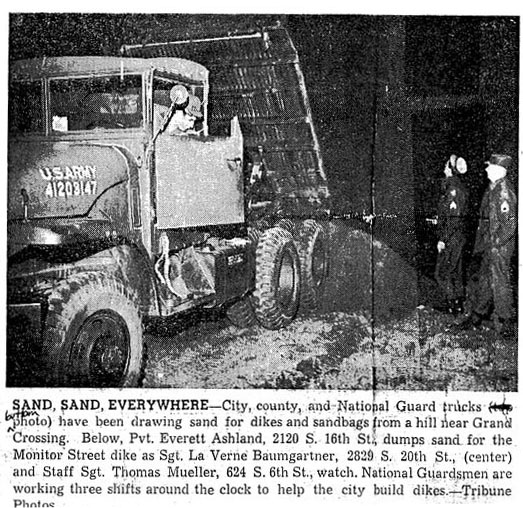Accidents & Disasters:
Resources
—Floods—
Author:
Corps of Engineers
Creator:
Department of the Army, St. Paul District, Corps of Engineers
Author:
La Crosse Public Library
Creator:
La Crosse Tribune
Description:
Newspaper articles related to floods in the city of La Crosse, Wisconsin. Major floods of the Mississippi River have greatly influenced where national, state and local project money has gone over the years. This collection of articles highlights the record-setting floods that La Crosse residents have experienced in 1880, 1951, 1952, 1965, 1969, 1993, 1997 and 2001. While the flood gage has been moved over time, the National Weather Bureau identifies the top five record high Mississippi River crests at La Crosse in this order: 1965, 1880, 2001, 1969, 1952.
Author:
Upper Midwest Environmental Sciences Center (Geological Survey)
Creator:
Upper Midwest Environmental Sciences Center (Geological Survey)
Description:
This site includes aerial obliques (photos), surface obliques (ground level photos) and video of the La Crosse and Coulee region of the Mississippi River suffering effects of flooding in April 2001.
Prepared by the Upper Midwest Environmental Sciences Center.
Prepared by the Upper Midwest Environmental Sciences Center.
Author:
University of Wisconsin-La Crosse Oral History Program
Description:
Bud Miyamoto (b. 1945) spends a majority of his interview remembering his early life in La Crosse, specifically life on the North Side as a Japanese American. Topics include but are not limited to: North Side neighborhood, his (white) mother's background and employment at the Auto-Lite factory, father’s service in the 100th Infantry Battalion during WWII and journey from Hawaii to La Crosse, Camp McCoy, local businesses (the Sweet Shop, the Country Kitchen, and the Riviera Theatre), social life and entertainment (school dances, drag races, movies, county fair, circus, and picnics), recreation and sports (swimming at the North Side Beach, softball at Copeland Park, and fishing on Black River), student rivalries between Central High School and Logan High School, health remedies, religion (St. Luke’s Methodist Church), anti-Japanese racism in town, Black Americans in La Crosse, Moss family, working-class cultures on North Side, Auto-Lite factory, community grief from 1959 lay-offs at Auto-Lite, employment (Manke Hardware Store, M. Lokken & Son Grocery, Neumeister’s Butcher Shop, Guggenbuehl and Nekola, Nelson’s Clothing Store, and Berg’s Pharmacy, Milwaukee Sentinel, the Sweet Shop, andSandy’s fast food), President John F. Kennedy, 1965 Flood, Lower North Side train depot, telephones, medical industry, and local radio.
Author:
University of Wisconsin-La Crosse Oral History Program
Description:
John Lysaker begins his interview discussing his education at Logan High School and school programs. Other topics include but are not limited to: Teacher's College, Catholicism, relations and businesses within ethnic groups, race relations, Rivoli Theatre and other movie theaters, carpentry, transportation, Copeland Avenue, railroad industry, the Great Depression, WWII, Korean War, Vietnam War, veterans, 1965 flood, train depots, technology changes (computers and calculators).
Author:
University of Wisconsin-La Crosse Oral History Program
Description:
Sylvan Arthur Schonsberg discusses his family background and life in La Crosse, Wisconsin. Topics include but are not limited to: 1965 Flood, hardware stores, Burlington Train Depot, WWII, entertainment (Avalon Ballroom, Riviera Theatre, Oktoberfest, Farm Fest fair, parades, Torchlight Parade), flea market, rivalry between Logan and Central High Schools, household appliances, stores in downtown La Crosse.
Author:
University of Wisconsin-La Crosse
Creator:
Manke, Greg
Description:
April 2001 brought widespread flooding of the Mississippi River to La Crosse, Wisconsin. This study compared two Landsat ETM satellite images, taken in April and September of 2001, to assess the geographical impact of the flood in the La Crosse area. The September image was used as the normal case and the April image was used as the flood case in order to draw statistical and spatial comparisons. By combining multi-spectral and panchromatic bands through a Brovey Transform resolution merge, the images were pan-sharpened to reveal the necessary information to give a detailed description of the flood. A classification of the transformed images shows how the river grew during the flood. A matrix function was used to produce an image that shows where flood waters resided during the flood.
Published as part of the University of Wisconsin-La Crosse Journal of Undergraduate Research, Volume 7 (2004)
Published as part of the University of Wisconsin-La Crosse Journal of Undergraduate Research, Volume 7 (2004)
Author:
Upper Mississippi River Basin Coordinating Committee
Creator:
Upper Mississippi River Basin Coordinating Committee
Description:
Appendix I: Flood Control (vol. V)
Item donated by the Upper Mississippi River Conservation Committee (UMRCC) to Murphy Library in 2018. Part of the UMRCC Collection housed at Murphy Library, University of Wisconsin-La Crosse.
Item donated by the Upper Mississippi River Conservation Committee (UMRCC) to Murphy Library in 2018. Part of the UMRCC Collection housed at Murphy Library, University of Wisconsin-La Crosse.
